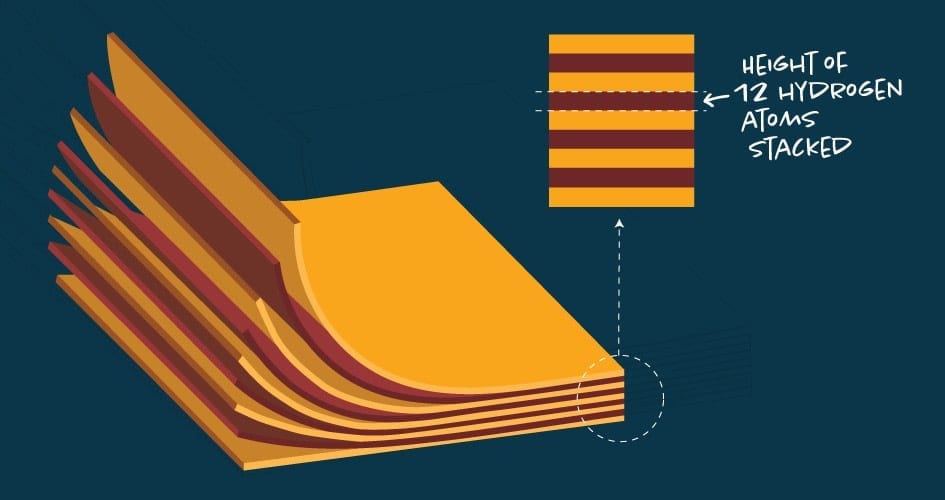
A new method allows scientists to craft individual tiny films, each just a few atoms high, and stack them for new kinds of electronics.
Folding Circuits Just Atoms Thick Using the Principles of Origami
Origami, the well-known Japanese art of paper folding, generates complex 3-D structures from flat 2-D paper. While the creation of a paper swan may be intriguing, the idea of creating 3-D circuits based on similar design principles is simply mindboggling. This science fiction-sounding research is a project that Jiwoong Park and colleagues from the University of Chicago have been developing over the last few years.
Park’s focus on large scale synthesis and device fabrication using ultra-thin materials has led to improvements in 2-D models and the introduction of 3-D vertically integrated devices. He will present the details of their circuit construction and its potential applications at the AVS 64th International Symposium & Exhibition, being held Oct. 29-Nov. 3, 2017, in Tampa, Florida.
Using atomically thin materials, Park synthesizes large scale integrated circuits that can be stitched together laterally to form a 2-D module. In their most recent project, his team has vertically integrated these 2-D modules to produce 3-D stacks.
Circuits have traditionally been developed using bulky substrate platforms, like silicon, and until recently were unable to function independently. Circuits based only on atomically thin materials liberate research from these conventional limitations. Combining various ultra-thin building blocks also allows for the integration of different electric and thermal properties within the same circuit, exponentially increasing functionality.
“For our research, we first generate atomically thin paper with different color[s] representing different electrical, optical, or thermal properties. We combine them in the lateral direction, equivalent to stitching. We stack them on top of one another, which is vertical integration. By doing so we are trying to develop large scale, fully functioning integrated circuits using these atomically thin materials as 2-D building blocks or color paper,” Park said.
The use of these ultra-thin materials, as opposed to typical components and resources, allows for a smaller circuit, but surprisingly not one that is microscopically small and therefore difficult to manipulate. The 2-D ingredients are assembled in such a way that they can be viewed with a simple optical microscope or even with the naked eye and can be handled accordingly.
Potential applications of this technology are also extensive. Similar to the way folding is applicable in objects used in day-to-day life, such as umbrellas or parachutes, integrated circuits would be able to contain a large surface area in a relatively condensed volume. Functionality in this context could be applied to a diverse set of new devices using the capabilities of condensed circuitry.
“What we are interested in developing is this mechanism of taking all these surfaces and device elements and folding them into tight spaces. Upon our cue, we want them to deploy to really large functioning surfaces,” Park said.
Learn more: Folding Circuits Just Atoms Thick Using the Principles of Origami
The Latest on: 3-D origami circuits
[google_news title=”” keyword=”3-D origami circuits” num_posts=”10″ blurb_length=”0″ show_thumb=”left”]- 3D-Printed Origami Pressure Sensor Array for Wireless Pressure Monitoringon April 18, 2024 at 7:01 pm
A recent study published in npj Flexible Electronics proposes a wireless pressure monitoring system using a 3D-printed origami pressure sensor array. It is equipped with customizable architecture ...
- 3-D Material with Controllable Shape and Size (IMAGE)on July 16, 2022 at 8:48 am
Harvard researchers have designed a new type of foldable material that is versatile, tunable and self actuated. Here a single cell is folds according to its actuation. Disclaimer: AAAS and ...
- The Coming Age Of 3D Integrated Circuitson February 7, 2016 at 11:19 pm
Many different circuits on the same die, tied together with three-dimensional interconnects. Image source: Pavlidis & Friedman, Three-dimensional Integrated Circuit Design (2010) In the late 1960s ...
- 3D Printing Circuits Gets Rid Of The Box Altogetheron January 5, 2015 at 8:21 pm
The funny thing is, we live in a three-dimensional world, and we like to shove these flat circuits into three-dimensional boxes. Well, what if we didn’t have to? What if the circuit could be ...
via Google News and Bing News









